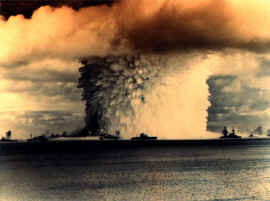By Dan Linehan
The rest of the hour-plus documentary focuses on what is euphemistically called the “Indian System,” the government’s plan to cheat Native Americans off their land, put them on reservations and kill those who resist.
“The ultimate goal is the land,” said Wolfchild, a Morton resident and member of the Mdewakanton community. The second and third parts of his nearly-finished documentary, “Stardreamers,” are about the 19th-century American legal system and the culture and politics of the Dakota.
Wolfchild said his documentary is a reaction to the histories that focused on the violence committed by Native Americans during the war.
“They had to make us look like savage human beings,” Wolfchild said, in order to justify treating them like savages.
The documentary, on the other hand, is all context. It relies heavily on the work of author and Minnesota native Mark Diedrich.
The “Indian System,” according to the documentary, starts with the removal of tribes from their land. For at least some of the Dakota, the most precious land was at the confluence of the Minnesota and Mississippi rivers. Wolfchild said it’s called “Bdote,” and said he believes it to be where his people were created.
Then, a treaty would require money to be paid in the compensation fund, which would be raided by traders to make up for debts both real and imagined. In this case, that meant a pair of treaties with the northern and southern bands, then called the Sioux.
Over time, their game disappeared and some Native Americans would grow dependent on the payments.
If the Dakota kept the peace, Wolfchild said, “they would be robbed.” And if they didn’t keep the peace, they would be decimated and moved.
And the treaties and negotiations were never really in good faith—the government didn’t believe it had much to lose by cheating.
This lack of context is still prevalent in America's schools and media. I doubt one in 10 Americans could accurately summarize the Indians' position. They'd say something like what centuries of moral midgets have said (see Uncivilized Indians). For instance:
If we can do it, so can the Indians. If we can kill 200,000 civilians in Hiroshima and Nagasaki to intimidate our foes, Indians could kill a few settlers here and there for the same reason. Only a hypocrite would think otherwise.
We were fighting for our existence--at least against the Axis powers. So were the Indians. It doesn't matter that the terrorists in this case were white Euro-Christians. With few exceptions, the Indians' actions were justified by the doctrine of self-preservation.
For more on the US-Dakota War, see Dakota Walk Commemorates War's Anniversary and Memorial Sought for Mankato 38.


I have read Deidrich's work, and a lot about the 1862 Dakota Uprising. I might be one of those one-in-ten.
ReplyDeleteThe traders indeed raided the compensation fund and left the Dakota to starve.
Yes, it seems in many ways typical of such situations all across the "frontier", from earlier years in the East, and into the West as the years went on.